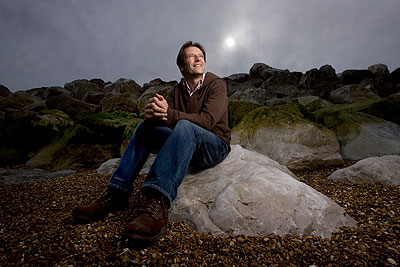 I was born by the sea, I live by the sea and I really enjoy shooting portraits by the sea. This example was of a young teacher who has moved his family to the coast to get a better way of life and he had given an interview to the paper about the way he lives – cycling to work, spending time with his family and generally making the most of the beaches in his area. My brief was simple – shoot a nice portrait on the beach!
I was born by the sea, I live by the sea and I really enjoy shooting portraits by the sea. This example was of a young teacher who has moved his family to the coast to get a better way of life and he had given an interview to the paper about the way he lives – cycling to work, spending time with his family and generally making the most of the beaches in his area. My brief was simple – shoot a nice portrait on the beach!
Most people assume that photographers like brilliant sunshine. I guess that most people only take pictures on nice sunny days because that’s their holidays and the scenery often looks better with brilliant blue skies and high contrast landscapes. People never look their best in direct sunlight – they squint and have heavy and horrible shadows around their eyes and faces. There are enough technique pieces on this web site about overpowering daylight for you to know how much trouble I go to to get rid of those nasty shadows. My subject for this portrait was disappointed when I arrived on an overcast and rather damp afternoon in June. I spent time assuring him that I was happy with the light and that we would end up with a better image and more interesting because of it. (more…)

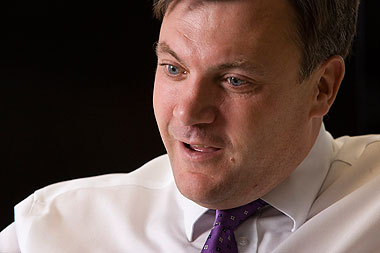 I have to shoot a lot of portraits during interviews and there have been several technique examples on this web site about the techniques and decisions that need to be made when doing that kind of work. This one isn’t about lighting set-ups or pre-planning – this is simply about seeing an angle and making the most out of it. This gentleman is Ed Balls: Member of Parliament and Secretary of State for Children, Schools and Families in Gordon Brown’s Government. The reporter had a short time to ask him questions from our readers and to conduct an interview around his responses. I had to shoot with my back to a glass wall and against the light. I set up a Lumedyne with a simple shoot through umbrella almost directly opposite the Secretary of State and behind the reporter. I had limited space in which to move and shoot.
I have to shoot a lot of portraits during interviews and there have been several technique examples on this web site about the techniques and decisions that need to be made when doing that kind of work. This one isn’t about lighting set-ups or pre-planning – this is simply about seeing an angle and making the most out of it. This gentleman is Ed Balls: Member of Parliament and Secretary of State for Children, Schools and Families in Gordon Brown’s Government. The reporter had a short time to ask him questions from our readers and to conduct an interview around his responses. I had to shoot with my back to a glass wall and against the light. I set up a Lumedyne with a simple shoot through umbrella almost directly opposite the Secretary of State and behind the reporter. I had limited space in which to move and shoot. I was inspired to share the “how” for this picture because of a comment from a colleague who said that I had been “lucky to find such a nice pool of light”. I was amused, annoyed and complimented all at the the same time because I created this light and he obviously thought that it looked as if it was a natural effect. Much of the best lighting looks as if it were not lit… so how was this one achieved?
I was inspired to share the “how” for this picture because of a comment from a colleague who said that I had been “lucky to find such a nice pool of light”. I was amused, annoyed and complimented all at the the same time because I created this light and he obviously thought that it looked as if it was a natural effect. Much of the best lighting looks as if it were not lit… so how was this one achieved? The great thing about creative flash is that you can play around and pretty much make it up as you go along. Learning from each set up as you go isn’t just a useful side effect it is the whole point. Just recently I have been hiding the flash in the picture a lot. This basically means that the light souce isn’t off to the side of the frame – it’s strategically hideen somewhere right there. I use doors and walls, poles and posts and even other people to mask the location of the flash, but it is there. This portrait of a teacher who does a lot of walking in the hills near his Dorset home is a useful case study. We had already shot quite a few really nice images of him using flash to overpower the daylight (see technique example here) and one of him walking without flash that you can see below:
The great thing about creative flash is that you can play around and pretty much make it up as you go along. Learning from each set up as you go isn’t just a useful side effect it is the whole point. Just recently I have been hiding the flash in the picture a lot. This basically means that the light souce isn’t off to the side of the frame – it’s strategically hideen somewhere right there. I use doors and walls, poles and posts and even other people to mask the location of the flash, but it is there. This portrait of a teacher who does a lot of walking in the hills near his Dorset home is a useful case study. We had already shot quite a few really nice images of him using flash to overpower the daylight (see technique example here) and one of him walking without flash that you can see below: 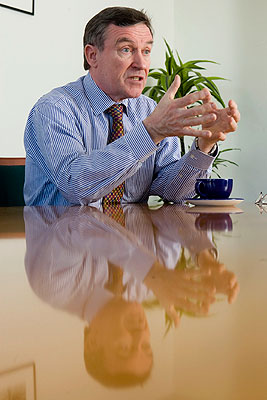
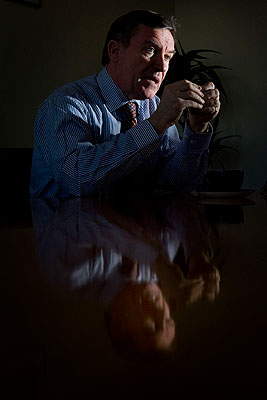 It has been a while since I added any new technique pages to the site so here is one that I have been meaning to do for quite a while. The idea here is to have two seperate lighting set-ups for one interview portrait without having to constantly move around the room adjusting lights. This interview was with a senior businerssman who chairs a body that decides how much teachers’ pay rises will be each year. The reporter wasn’t all that comfortable with me shooting through the interview but it was what the picture editor wanted, so that’s what I did. This job required a bit of quick thinking so that I could get two different set-ups in place.
It has been a while since I added any new technique pages to the site so here is one that I have been meaning to do for quite a while. The idea here is to have two seperate lighting set-ups for one interview portrait without having to constantly move around the room adjusting lights. This interview was with a senior businerssman who chairs a body that decides how much teachers’ pay rises will be each year. The reporter wasn’t all that comfortable with me shooting through the interview but it was what the picture editor wanted, so that’s what I did. This job required a bit of quick thinking so that I could get two different set-ups in place.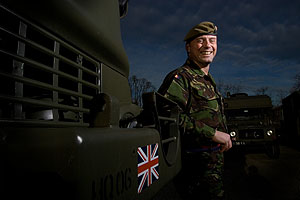
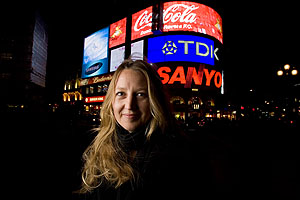
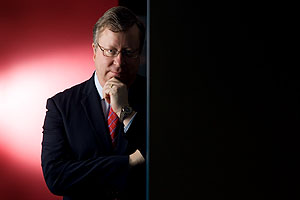 Important people often need to be photographed in a way that makes them look powerful. Some of them even like to be seen looking down at you, which is madness when you consider that 99% of people looking down get two chins! This portrait of the Chief Executive of a government agency was made at their offices in London where I had to wait whilst another photographer shot him first. My picture editor had agreed that we would get access to a flat roof area outside if the weather was good so that we could take advantages of the most famous backdrop that I know: Big Ben.
Important people often need to be photographed in a way that makes them look powerful. Some of them even like to be seen looking down at you, which is madness when you consider that 99% of people looking down get two chins! This portrait of the Chief Executive of a government agency was made at their offices in London where I had to wait whilst another photographer shot him first. My picture editor had agreed that we would get access to a flat roof area outside if the weather was good so that we could take advantages of the most famous backdrop that I know: Big Ben.
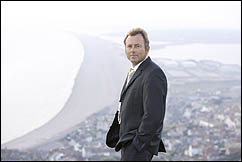
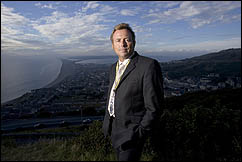 When I was searching for an opening image for a recent “dg28 live” seminar I only had to look back a few days to find this example of exactly WHY WE USE LIGHTS.
When I was searching for an opening image for a recent “dg28 live” seminar I only had to look back a few days to find this example of exactly WHY WE USE LIGHTS.